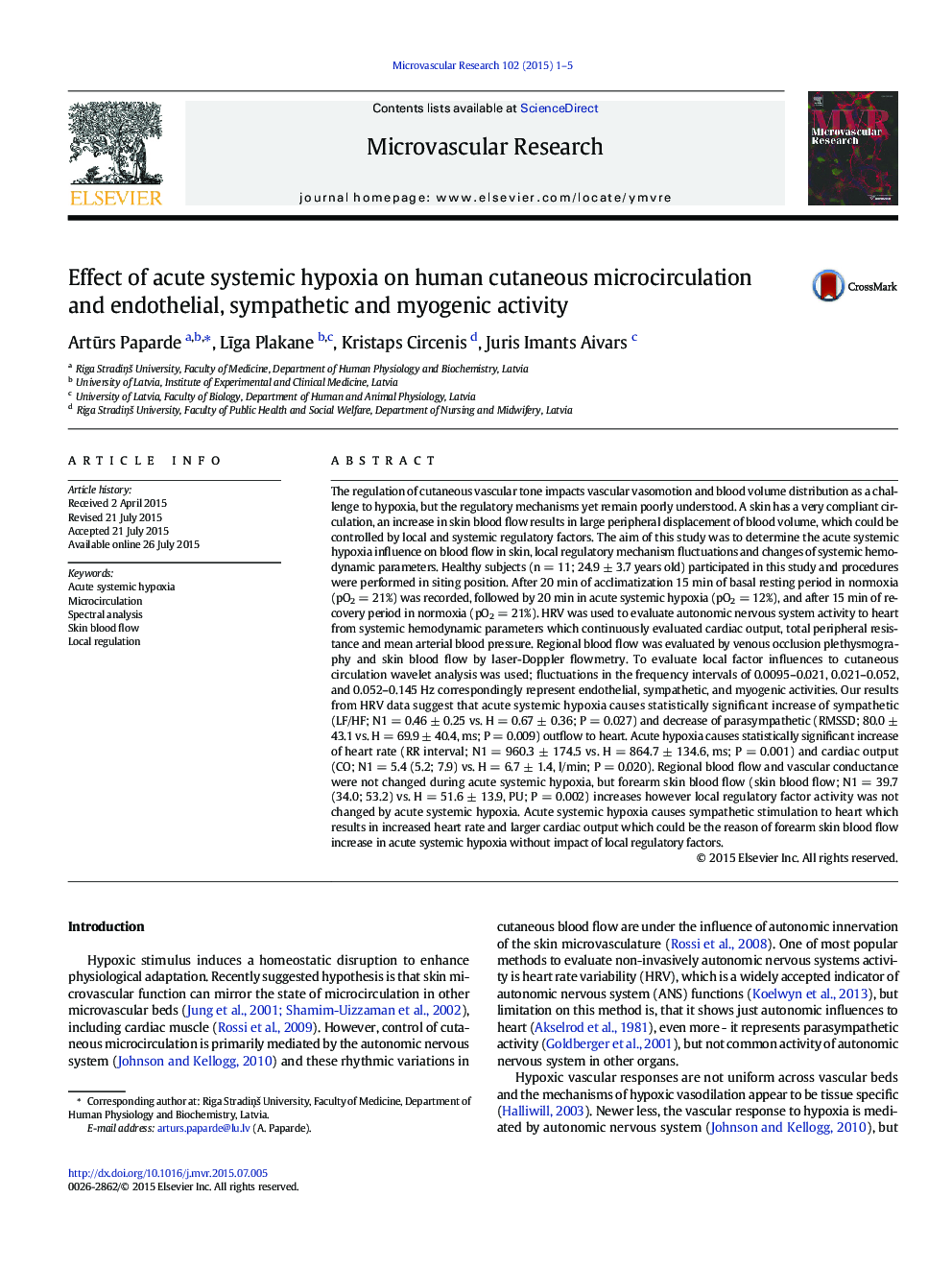| کد مقاله | کد نشریه | سال انتشار | مقاله انگلیسی | نسخه تمام متن |
|---|---|---|---|---|
| 1994703 | 1541282 | 2015 | 5 صفحه PDF | دانلود رایگان |
عنوان انگلیسی مقاله ISI
Effect of acute systemic hypoxia on human cutaneous microcirculation and endothelial, sympathetic and myogenic activity
ترجمه فارسی عنوان
اثر هیپوکسیا سیستمیک حاد بر میکروسیرکولا پوستی انسان و فعالیت اندوتلیال، سمپاتیک و میوگنیک
دانلود مقاله + سفارش ترجمه
دانلود مقاله ISI انگلیسی
رایگان برای ایرانیان
کلمات کلیدی
موضوعات مرتبط
علوم زیستی و بیوفناوری
بیوشیمی، ژنتیک و زیست شناسی مولکولی
زیست شیمی
چکیده انگلیسی
The regulation of cutaneous vascular tone impacts vascular vasomotion and blood volume distribution as a challenge to hypoxia, but the regulatory mechanisms yet remain poorly understood. A skin has a very compliant circulation, an increase in skin blood flow results in large peripheral displacement of blood volume, which could be controlled by local and systemic regulatory factors. The aim of this study was to determine the acute systemic hypoxia influence on blood flow in skin, local regulatory mechanism fluctuations and changes of systemic hemodynamic parameters. Healthy subjects (n = 11; 24.9 ± 3.7 years old) participated in this study and procedures were performed in siting position. After 20 min of acclimatization 15 min of basal resting period in normoxia (pO2 = 21%) was recorded, followed by 20 min in acute systemic hypoxia (pO2 = 12%), and after 15 min of recovery period in normoxia (pO2 = 21%). HRV was used to evaluate autonomic nervous system activity to heart from systemic hemodynamic parameters which continuously evaluated cardiac output, total peripheral resistance and mean arterial blood pressure. Regional blood flow was evaluated by venous occlusion plethysmography and skin blood flow by laser-Doppler flowmetry. To evaluate local factor influences to cutaneous circulation wavelet analysis was used; fluctuations in the frequency intervals of 0.0095-0.021, 0.021-0.052, and 0.052-0.145 Hz correspondingly represent endothelial, sympathetic, and myogenic activities. Our results from HRV data suggest that acute systemic hypoxia causes statistically significant increase of sympathetic (LF/HF; N1 = 0.46 ± 0.25 vs. H = 0.67 ± 0.36; P = 0.027) and decrease of parasympathetic (RMSSD; 80.0 ± 43.1 vs. H = 69.9 ± 40.4, ms; P = 0.009) outflow to heart. Acute hypoxia causes statistically significant increase of heart rate (RR interval; N1 = 960.3 ± 174.5 vs. H = 864.7 ± 134.6, ms; P = 0.001) and cardiac output (CO; N1 = 5.4 (5.2; 7.9) vs. H = 6.7 ± 1.4, l/min; P = 0.020). Regional blood flow and vascular conductance were not changed during acute systemic hypoxia, but forearm skin blood flow (skin blood flow; N1 = 39.7 (34.0; 53.2) vs. H = 51.6 ± 13.9, PU; P = 0.002) increases however local regulatory factor activity was not changed by acute systemic hypoxia. Acute systemic hypoxia causes sympathetic stimulation to heart which results in increased heart rate and larger cardiac output which could be the reason of forearm skin blood flow increase in acute systemic hypoxia without impact of local regulatory factors.
ناشر
Database: Elsevier - ScienceDirect (ساینس دایرکت)
Journal: Microvascular Research - Volume 102, November 2015, Pages 1-5
Journal: Microvascular Research - Volume 102, November 2015, Pages 1-5
نویسندگان
Artūrs Paparde, Līga Plakane, Kristaps Circenis, Juris Imants Aivars,
